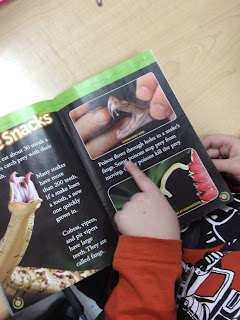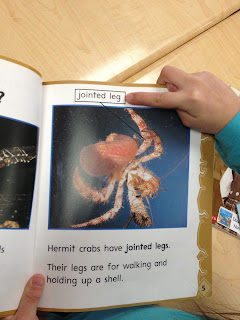If you walked into my room this week during our whole group mini-lessons, this is what you would have heard:
Me: "We've been finding and studying nonfiction text features. What do we know about nonfiction text features?"
Kids: "You Can't Ignore!"
Me: "Why?!"
Kids: "They tell us more!"
:) ...I have nothing to say except that I fully admit I am nerdy and super cheesy when I teach! Sometimes I'm scared I suck all of the "coolness" out of my kids by the time they leave me in the spring. I worry I've turned them all into cheesy kids who will walk down the hallways of their corporate offices holding up the quiet sign as adults...
However, my kiddos can definitely tell me now that you can't ignore text features because they tell us so much more about the topic! They LOVE nonfiction books and it is my favorite genre to teach. Children are fascinated by the photographs, the facts, and their ability to bring some prior knowledge into books about animals, nature, and the world around them. Nonfiction books are natural motivators of reading to most children, and as teachers, we need to take every opportunity to tap into that motivation.
In our building, we use the Comprehension Toolkit a lot. Have you used this or seen this? If not, it is a true treasure! Click on the link to take you to the website and learn more. The pack comes with some amazing read alouds (which contain lots of stretched texts for us as we dig into the Common Core). In addition, it walks you through some great ways to get students engaged in text in the areas of monitoring, making connections, questioning, summarizing & synthesizing, visualizing, inferring, and determining the importance of text. Once you feel comfortable with the layout of the lessons, you can use the structure of them with any text that you feel is worthy of studying and digging into with your kids.
This week, we used an article on spiders, a National Geographic Explorer magazine, and a book about tornadoes to discover and learn about text features. We studied one to two features a day and had discussions about what the purpose of each feature is. We made thisreally ugly features/purpose chart as we were reading together.
Then, we searched through our nonfiction bookshelf baskets and found as many features of text as we could to share with our tables and friends. It was so fun to hear them calling out the names of the features and getting excited to discover a glossary or a caption.
Me: "We've been finding and studying nonfiction text features. What do we know about nonfiction text features?"
Kids: "You Can't Ignore!"
Me: "Why?!"
Kids: "They tell us more!"
:) ...I have nothing to say except that I fully admit I am nerdy and super cheesy when I teach! Sometimes I'm scared I suck all of the "coolness" out of my kids by the time they leave me in the spring. I worry I've turned them all into cheesy kids who will walk down the hallways of their corporate offices holding up the quiet sign as adults...
However, my kiddos can definitely tell me now that you can't ignore text features because they tell us so much more about the topic! They LOVE nonfiction books and it is my favorite genre to teach. Children are fascinated by the photographs, the facts, and their ability to bring some prior knowledge into books about animals, nature, and the world around them. Nonfiction books are natural motivators of reading to most children, and as teachers, we need to take every opportunity to tap into that motivation.
In our building, we use the Comprehension Toolkit a lot. Have you used this or seen this? If not, it is a true treasure! Click on the link to take you to the website and learn more. The pack comes with some amazing read alouds (which contain lots of stretched texts for us as we dig into the Common Core). In addition, it walks you through some great ways to get students engaged in text in the areas of monitoring, making connections, questioning, summarizing & synthesizing, visualizing, inferring, and determining the importance of text. Once you feel comfortable with the layout of the lessons, you can use the structure of them with any text that you feel is worthy of studying and digging into with your kids.
This week, we used an article on spiders, a National Geographic Explorer magazine, and a book about tornadoes to discover and learn about text features. We studied one to two features a day and had discussions about what the purpose of each feature is. We made this
While I'm talking about nonfiction text, I wanted to share the National Geographic Young Explorer website with you. Most of you probably already know about it, but I was surprised that I had not yet come across this great resource! It is filled with digital issues of all the magazine articles that you can access with your kids online. I'm going to use them as Close Reads for the CCSS, as I have had a hard time finding text that is appropriate for first grade Close Reads. You can access the articles by clicking the link below. They are so fun - and free! :)
And - before you go - I created this Features/Purpose chart for my kiddos to fill in this week as we studied each of the nonfiction text features. It was easier for them to record the purpose of each feature in boxes rather than a simple T-Chart. You could also turn this into an activity by giving them a nonfiction book and having them write down the page number they found each of the text features on. Grab it for free by clicking the picture below and downloading it from Google Docs. - Enjoy and thanks for stopping by! :)
Happy Learning,
















